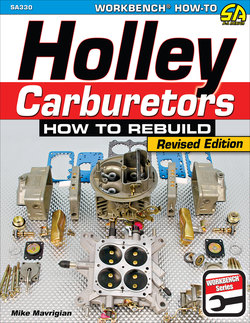Читать книгу Holley Carburetors - Mike Mavrigian - Страница 6
На сайте Литреса книга снята с продажи.
ОглавлениеINTRODUCTION
During the 1950s and 1960s, the Holley 4-barrel carburetor established itself as the clear leader in high-performance operation because it provided precise fuel metering in low-, mid-, and high-RPM operation. Also, it was a modular design that was easy to tune and had a wide range of parts. The Holley 4150-series, or Double Pumper, carburetor distinguished itself during the muscle car era because it had an accelerator arm pump on both float bowls, so if the carburetor were used for aggressive acceleration or wide-open throttle, it would deliver all the needed fuel into the engine when called upon.
Although the basic architecture of the Holley 4-barrel carburetor has remained largely the same for 60 years, Holley has offered several different series of carburetors, such as the 4150, 4160, Avenger, and Dominator. And of course, many different carburetor models exist within these series. In this book, I review Holley carb styles, models, features, and sizes, so you can accurately identify your particular carburetor and its parts.
Many classic cars, muscle cars, hot rods, street rods, and competition cars are equipped with Holley carburetors. If you have an OEM Holley carburetor, it is most likely 30 years or older. Over time, gaskets deteriorate and bushings wear and possibly leak, metering blocks and jets are exposed to contaminants and become plugged, jet needles and jets wear from use and no longer meter properly. If you have an aftermarket carburetor, it may be newer but a lot of usage may require a rebuild. Or possibly, you want to substantially change the setup of your carburetor. Whatever your situation, if you have never worked on a carburetor before, rebuilding one can seem daunting.
The purpose of this book is to take the mystery out of the carburetor rebuild process, and to show you how to do it in straightforward, clear steps. This includes how to disassemble, select parts, install components, and confidently reassemble a carburetor, so your engine and vehicle performs at its best. In the pages of this book, I have documented the entire Holley carburetor rebuild procedure so you disassemble, evaluate, replace worn/defective parts, reassemble, and perform basic calibration. The step-by-step photos illustrate how to perform each step, and the captions explain the tools and techniques required to perform the procedure.
Before you dive into rebuilding a Holley carburetor, it’s important to understand how it operates. Carburetors are relatively complex devices, and they have a number of circuits, venturis, orifices, and other features. You need to understand how a carburetor and each component functions so you can properly rebuild and tune it. I have included a comprehensive parts guide that provides the available parts for a particular model, so you can select the correct jets, needles, emulsion tubes, and other parts for optimal performance. I also help you select a vacuum or mechanical secondary carburetor for your particular engine and application. Holleys can be set up and calibrated for almost any engine, vehicle, and application.
If you have built a modified engine or if you’re buying a new carburetor for a particular engine, you need to select the correct CFM (cubic flow per minute) size. Feed too much fuel to the engine and it will sputter and stumble or, in extreme cases, not start. Supply too little fuel and the engine runs out of power on the top end. The instruction and mathematical formulas allow you to select the right carburetor.
Holley 4-barrel carburetors have a number of jets, needle jets, main jets, and power jets; all of the parts must be tuned as a well-integrated system if you want to get maximum fuel efficiency and performance. This book does not delve into performance modifications. But if you’re looking to setup your Holley Dominator, which is installed on a big-block Chevy, and you plan on drag racing, I suggest you refer to How to Super Tune and Modify Holley Carburetors by David Vizard. In that book, Vizard uses 50-plus years of engine calibration experience and knowledge so you can tune your carburetor for maximum performance for almost any application, high-performance street, drag race, road race, and almost every other form of competition. He also explains how to calibrate the carburetor for almost any engine setup.
With this book in hand, you will be better able to understand your Holley’s functions and how to perform do-it-yourself repairs and rebuilding to obtain a fresh, like-new carb, in terms of on-engine function. If you’ve never worked on a Holley carburetor before, or if you have dabbled but have questions regarding specific components and disassembly/assembly operations, this book is designed to answer all of your questions. I’ve also included information that is helpful when choosing a carb for a specific application, in terms of features and CFM size.
Welcome to the world of Holley carburetors.
